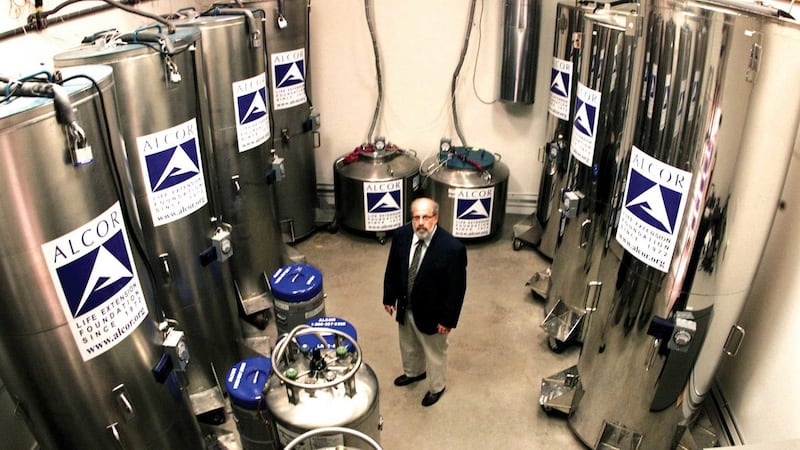It is an urban myth that Walt Disney was the first person to be cryogenically frozen, and stored in liquid nitrogen, following his death in 1966.
But neither was the British 14-year-old -- who this week was revealed to have won a landmark legal battle to have her body cryogenically preserved -- the earliest pioneer in a field of science that is still fraught with uncertainty, and mired in debate.
The body of the teenager, who died in October of a rare form of cancer, was flown with the permission of the British courts to the U.S., where it will be stored until a possible future collision of science and technology -- drawing on fields like nanotechnology, molecular biology, stem cell research and 3D printing -- makes ‘reanimation’ possible.

She is one of around 250 other people who, according to a paper published in the Journal of Medical Ethics last year, have so far been cryopreserved in the US. Around two dozen more, from all over the world, are being stored at a facility in Russia. Worldwide, at least 1,500 more have signed up for the service.
Four years ago, a 23-year-old American woman, Kim Suozzi, briefly became a social media sensation, after she took to the chat forum Reddit in an attempt to crowdfund cryonic storage of her brain, so that its contents could later be uploaded onto a computer. At the time, she said she believed preservation had a "1 or 2 per cent chance" of offering her another shot at life.
Suozzi was successful in raising the €75,000 necessary, and her head is now in storage at the Alcor Life Extension Institute in Scottsdale, Arizona, awaiting 'mind uploading'.
The notion that what cryonicists prefer to call “a legally dead” person could be brought back to life with the help of future advances is no longer as fantastic as it once was.
Earlier this year, scientists from 21st Century Medicine (21CM) in California managed to cryogenically freeze the brain of a rabbit and recover it in a "near-perfect" state. They are currently awaiting the results of a similar experiment on a pig.
Cryopreservation involves a two-step process. The first step is vitrification - in which over 60 percent of the water inside cells is replaced with protective chemicals, which prevents ice damage. The body is then preserved in liquid nitrogen at temperatures of minus 196 degrees Celsius which, proponents say, can stave off decay for centuries.
Worldwide, there are three facilities offering cryopreservation - two in the U.S. and one in Russia. Another is due to open in Australia next year. Naturally, the promise of biological eternal life doesn't come cheap. In the early days of cryonics, the continued storage of preserved bodies was kept up by payments from relatives of the deceased. If the relatives stopped paying, the bodies were defrosted.
The field hit a major PR setback in the 1970s, when a facility in California ran out of money and began stuffing too many bodies into the same capsule. Two capsules broke down, and nine bodies decomposed.
Now patients are expected to pay for everything in advance, often through life insurance policies.
The ‘lifetime’ cost cited in the court ruling on in the British girl’s case was €43,000. A scan of the fees charged at the handful of organizations offering cryopreservation reveals that this may be just the tip of the iceberg.
Full body cryopreservation can cost as much as €207,000. The cost of neuropreservation, or 'head only' preservation, starts from around €17,000, but can run much higher. The Alcor Life Extension Foundation, for instance, charges €75,000 for head-only preservation. About one third of this goes to the medical team that will be on standby at the time of death, and one third goes into a fund for future revival. The investment income from the trust pays for the storage in liquid nitrogen.
At the Detroit-based Cryogenics Institute, which recently admitted in its 140th 'patient', the minimum cost of preservation is €26,000 for lifetime members. But when the cost of cooling and transportation is included, the fee is more likely to be in the region of €82,000 for lifetime members, or €90,000 for annual members. On top of this, there are additional costs including transportation, funeral director's fees, and the fee for membership of the institute (€1,178 for lifetime membership or €113 annually). The Cryogenics Institute suggests would-be patients take out an insurance policy - or, in some circumstances, use the value of their house to pay for the procedure, in exchange for "a somewhat larger than usual suspension fee".
KrioRus, in Russia, offers a starting price of €26,000 - however it warns that it will not revive patients until the cost of doing so falls below “the amount set aside for the cryopreservation”. It also urges would-be clients to take out insurance to cover the cost.
Despite the scientific uncertainty, the legal ambiguity in some areas, and the prohibitive costs, the popularity of cryonics is growing steadily.
The PayPal founder Peter Thiel, who is a member of Alcor and currently being tipped for a role in the White House, is a fan of the technology, insisting "cryonics only seems disturbing because it challenges our complacency about death."









